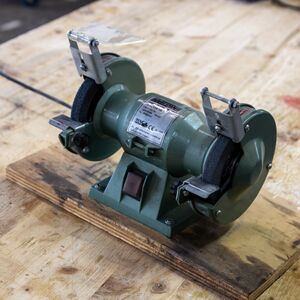Bench Grinders: Difference between revisions
m →Sharpening: lower level headline |
No edit summary |
||
| Line 4: | Line 4: | ||
|synonyms=bench top grinder, grinding wheel;<br>DE: Doppelschleifer, Schleifbock,<br>''Trockenschleifmaschine'' | |synonyms=bench top grinder, grinding wheel;<br>DE: Doppelschleifer, Schleifbock,<br>''Trockenschleifmaschine'' | ||
|type=power [[sharpening]] tool | |type=power [[sharpening]] tool | ||
|access=upon introduction | |access=upon [[Bench Grinder Introduction|personal introduction]] | ||
|location=[[Metal Workshop|metal workshop]] | |location=[[Metal Workshop|metal workshop]] | ||
|material=[[metal]] | |material=[[metal]] (not [[aluminum]]) | ||
|tutors=[[User:Lukas|Lukas]] | |tutors=[[User:Lukas|Lukas]] | ||
|similar=[[Disc Grinder|disc grinder]], [[files]], [[sandpaper]] | |similar=[[Disc Grinder|disc grinder]], [[files]], [[sandpaper]] | ||
Revision as of 14:53, 23 September 2018
| ToolInfoBox Brüder Mannesmann M1225-125 | |
|---|---|

| |
| Synonyms: | bench top grinder, grinding wheel; DE: Doppelschleifer, Schleifbock, Trockenschleifmaschine |
| Type: | power sharpening tool |
| Material: | metal (not aluminum) |
| Location: | metal workshop |
| Access Requirements: | upon personal introduction |
| Tutors: | Lukas |
| Manual: | Völkner.de |
| Similar (More or Less): | disc grinder, files, sandpaper |
This bench grinder from 1996 is used but still in decent condition; the wheels run true and quietly. The grinder is equipped with two different stone wheels with different grits (35 & 60); one for heavy-duty and quick material removal, one for a finer and more precise material removal that will leave a way nicer surface finish.
Safety
As the bench grinder is not only a power tool but one with openly accessible spinning parts, precautions need to be made. Have a tutor show the machine to you before touching it!
- never wear gloves and/or scarves, roll up long sleeves and tie back long hair so nothing gets caught
- always wear personal protection, especially safety goggles and if necessary some ear defenders and a dust mask
Usage
- after plugging the grinder in, turn it on and wait until it reaches its final speed
- if you hear any rattling or other funny noises turn it off immediately and check whether something is loose or whether tiny parts are inside of the casing
- grind whatever you want to grind by holding it against the stone wheel; make sure the piece is supported either by the little table in front of the wheel or some other structure
- do not force your workpiece onto the wheel as that will produce a lot of heat; cooling your piece from time to time is always a good idea
Sharpening
- approach the spinning wheel slowly so your workpiece doesn't catch on it!
- when sharpening hardened steel make sure to keep the blade cool, otherwise previous hardening may be undone!
- it's a good idea to press the blade firmly against the support to keep a consistent blade alignment
- check the squareness of the blade often to be able to make corrections
- keep in mind that the grinder itself is only for roughing out the blade geometry, for a truly sharp blade you definitely need to work with some wetstones afterwards
Maintenance
The wheels need to be "dressed" from time to time in order to produce nice straight edges and maintain stability. Apparently, it's possible to do that with nothing more than a few spring washers on a piece of threaded rod![1] We should try this before spending time and money on a more sophisticated tool.
Changing Wheels
After installing a new grinding wheel, set up a safety perimeter (let's say everyone leaves the room) and let the grinder run for five minutes. Only if that went well, without suspicious noises or visible signs of problems, should the grinder be used again.
Upgrade Ideas
For really sharp knives, we could turn an MDF wheel on the wood lathe and use that as the final "grit".